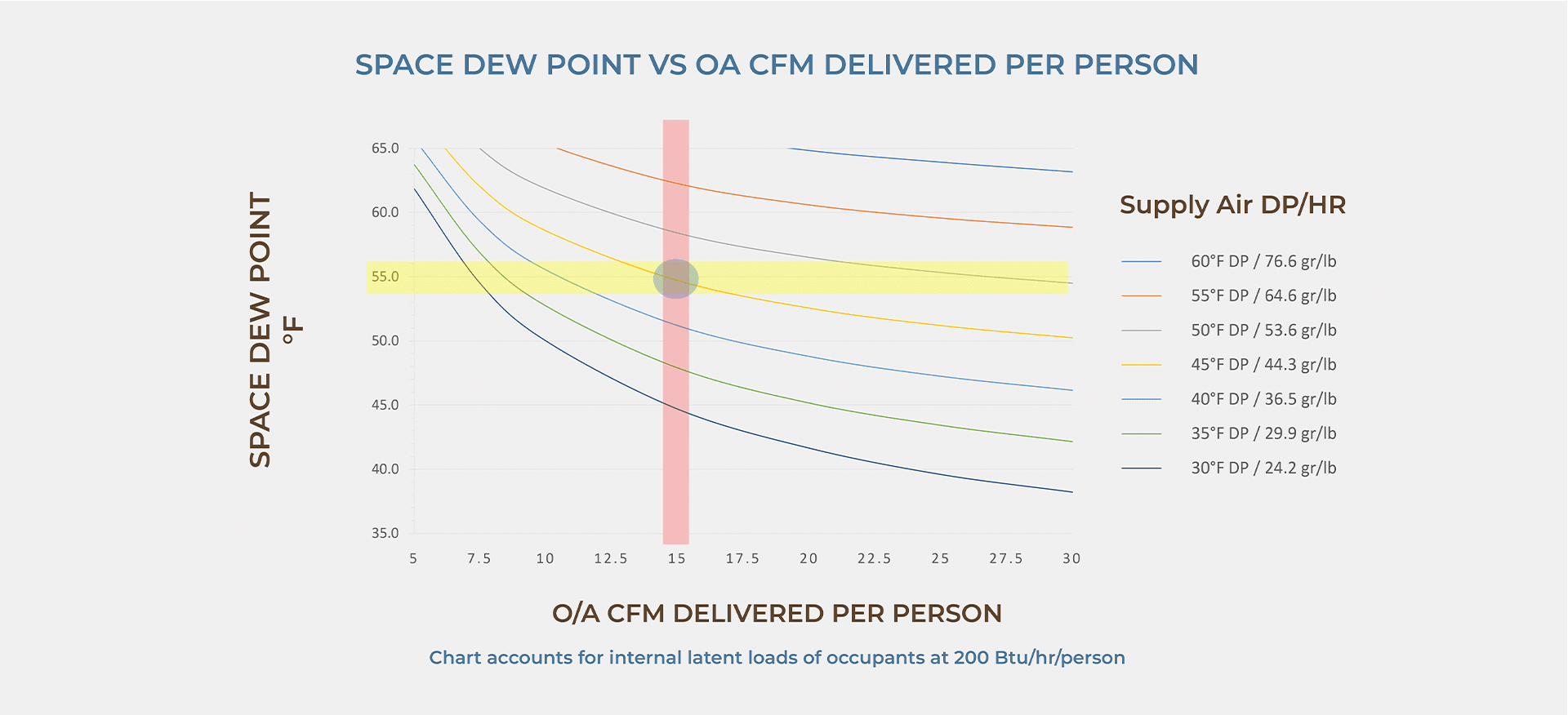DOAS– Perfected by EI Solutions!
Experts agree decoupling outside air loads from internal building loads saves energy!
Outside air (OA) provides fresh air for occupants, dilutes airborne contaminants and pressurizes buildings. Proper ventilation, along with controlling humidity, improves comfort and productivity. Studies show proper humidity control is necessary to maintain a healthy environment, reduce building maintenance and protect the building envelope from deterioration and damage caused by corrosion and mold.
Outside air represents the largest moisture source in most buildings and therefore requires active dehumidification to be the primary purpose of any DOAS. Despite this, some DOAS manufacturers continue to promote standard HVAC equipment to address dry bulb (DB) design conditions while neglecting the higher moisture load associated with peak dehumidification design (based on dew point/DP).This results in selecting systems with too high of a sensible heat ratio making them incapable of providing the necessary moisture removal during all weather conditions.
EI Solutions (EIS) is committed to delivering intelligent solutions designed to successfully pre-condition OA, regardless of conditions, Our DOAS equipment delivers the specific dew point temperature required to address all external and internal latent loads. This allows cooling equipment (whether external to the DOAS or packaged within) to address only the space sensible cooling requirements which reduces overall tonnage and saves energy. Additionally, since sensible only cooling coils operate dry (and cleaner), this strategy provides the opportunity to incorporate highly efficient cooling technologies like radiant panels, chilled beams and VRF (Variable Refrigerant Flow) with increased confidence.
Key Points for DOAS
- Size DOAS for dew point design conditions.
- Check performance at peak & off-peak conditions.
- Deliver the right Dew Point! (see Figure 1)
While every EI Solutions product is capable of being applied as a DOAS, we recommend our FreeDry Series as the first consideration. By optimizing a combination of active desiccant dehumidification and cooling, the EIS FreeDry Series dehumidifies OA with less cooling tonnage than other systems. Better humidity control while saving energy dollars is a definite “Win-Win”.
Flexibility Matters
While daily internal building loads tend to not fluctuate, outside air conditions can change drastically through the seasons and sometimes in a day. The DOAS must be able to accommodate the varying loads. It is prudent to verify performance and efficiency at design day conditions (both dry bulb and dew point) and part load conditions. Providing sufficient moisture removal capacity to overcome temporary loads (i.e., housekeeping activities, occupants entering building on a rainy day) should be considered so as not to allow excess moisture to accumulate in the space.
Although DOAS units should be sized to manage design dew point conditions, it is also critically important to assure the DOAS (remember it is the most powerful dehumidifier serving the building) maintains space dew point below 60oF during occupied and unoccupied periods per ASHRAE 62.1-2022. Additionally, when unoccupied for more than 12 hours indoor humidity must not exceed 65% RH.
Maintaining a healthy building environment requires:
- Proper ventilation and filtration.
- Controlling temperature and humidity for occupant comfort.
- Studies show we are more productive when comfortable, student tests score increase, absenteeism is reduced.
- Studies show people are comfortable at higher temperatures when humidity levels are lowered.
- Prevention of mold, mildew and other indoor irritants.

Dedicated Outside Air Systems
- Outside air is the largest moisture load in almost every commercial building.
- It makes sense to dehumidify OA at the source before entering building or other HVAC equipment.
- Required ventilation rates are mandated by building codes, but generally follow ASHRAE Standard 62.1.
- Care should be taken to ensure ventilation amount satisfies make up air needs to avoid negative building pressure to combat infiltration and unwanted moisture.
Preconditioning outside air before introducing it to buildings is widely accepted as a responsible design. HVAC industry organizations and experts agree decoupling the outside air loads from internal building loads saves energy and allows for better humidity control which protects occupants and the building envelope itself. Although the primary purpose of a DOAS is to dehumidify, many DOAS manufacturers promote their standard DX mechanical cooling equipment as “good enough”. EI Solutions is committed to delivering intelligent solutions for treating outside air.
Some might consider desiccant dehumidification as “overkill” to maintain typical comfort conditions (75o FDB, 50% RH, 55o FDP); however, the DOAS should eradicate moisture loads from outside air and also address all internal latent loads. This means the DOAS needs to consistently deliver a dew point temperature significantly below space dew point design (typically 45o F dew point) to meet internal moisture loads. That goal is not an easy task for common DX systems, especially during off-peak conditions.

EI Solutions desiccant dehumidification systems successfully pre-condition OA to the desired delivered dew point allowing space cooling equipment to address only the sensible cooling requirements. This strategy allows the secondary equipment to operate at higher suction temperatures and run dry and clean. Additionally, because all the external and internal moisture loads are managed with an EI Solutions DOAS the use of highly efficient cooling technologies like radiant panels, chilled beams and VRF (Variable Refrigerant Flow) is supported perfectly since such systems are typically not designed to manage moisture removal.




